It was too great an opportunity to turn down.
The US Navy public affairs division invited me to tour the inside of the USS New Jersey (SNN-796). Besides feeling privileged to be able to tour the underwater boat that is the finished product of more than nine years of hard work, skill and perfection since her keel was laid in 2016, I was more than curious to see how and where more than 130 men and women can live , work, eat and sleep 24-7 in a closed very compact environment that does not see the light of day.
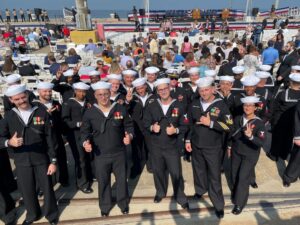
Photo courtesy Gary Lehman
So we media were invited to tour the boat the day before she was commissioned. The Middletown Township trio of hardworking women who never seem to take a minute’s break in keeping everyone informed on everything the township and its officials are doing were also invited to tour. So it was a joy to go up and down ladders, squeeze through narrow hallways and oh and ah over the marvels and wonder of the Submarine New Jersey with Tara Berson, Gianna Piroso and Raven Rentas along with sensational photographer Bill Fischer who captured everything on camera, including proof that we truly were on the submarine New Jersey.
It got even better when I saw our tour guide through the boat was STS2 (SS) Christopher D. Baldwin, who by this time felt like an old friend. I had met Baldwin when he, the ship’s captain, Commander Steve Halle and five crew members visited MAST and thanked the NJROTC cadets for the gift they had presented to the crew.
Mr. Baldwin is part of the ship’s SONAR Division, known as the eyes and ears of the sub when she’s underwater. It’s he and the men and women sailors with him who make use of all that secretive equipment to detect, track and classify everything, be it surface or submerged, with which they come in contact. They’re the ones who help navigate the boat through all kinds of weather using their sonar equipment to ensure accuracy.
So Mr. Baldwin brought us aboard. I don’t know about anybody else, but my first shock was the texture of the deck. I knew it was curved and would take attention to walk carefully…fairly easy to fall over with lack of attention.
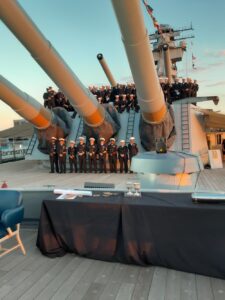
But I had not thought about the fact of course the deck would not be teak wood like the Battleship New Jersey, nor would it be shiny and smooth. Of course it was black, of course it was rough enough so appropriate footwear, sneakers and Skechers worked great, could grab a firm hold and make you feel secure. You’re walking on an angle, only a few feet off the water.
That worked just fine, felt wonderful and was a first step. So it was down the first ladder to get to the deck below.
No problem there. One giant step to the first step of the ladder then an easy step down the firm steps to the deck below, the narrow space and the first view of what life undersea looks like in a 377-foot-long boat. Mr. Baldwin was great, eager to share whatever information he could, eager to let us know the precise purpose for every little thing that took up any inch of space on the craft and obviously well-versed in everything about his home under the water.
Going through two decks of rooms, equipment, touching torpedoes and torpedo tubes, and hearing more than any of us neophytes could handle, Mr. Baldwin took us into Command & Control, the control room of the boar with tis huge screen visual displays of pictures from the mast, digital navigation and the sailors at work in front of the screens even as we paraded through their work area.
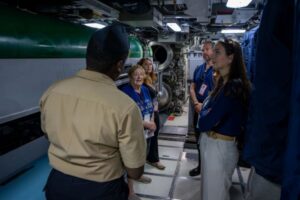
Photo Courtesy Bill Fischer
We learned about the ballast tanks and how they’re flooded to submerge the vessel or blown out to bring it to surface. We learned how the boat makes its own oxygen, water, and fuel, everything a boat and its crew needs except food.
We interrupted a team of sailors while they were chowing down some lunch, helping themselves from the buffet set up with salads, beans, vegetables and a wide variety of other healthy eats in the Ward Room.
Seeing the sailors eat sandwiches made me think of Commander Halle’s remarks at another event when he said given the atmospheric differences, pressure etc. on a boat, it takes a real talent to ensure great yeast rising bread in a sub.
We also learned that where they sit at tables for their meals is the same place where they have movies or any recreational activities. It’s also the area where those in any need of medical services are taken. That’s why it’s called the Ward Room, as in a wardroom in a hospital. There isn’t a wasted or unused spot on a submarine.
We saw the Captain’s quarters, a wee space complete with desk and lots of notes on his walls, the XOs space, a bit smaller, but equally efficient, and the side-by-side beds of the crew. Granted, this boat also has berths atop each other, with drapes in front similar to old sleeping cars on trains, only smaller. But it also has lines of beds side by side, with enough room between simply to tuck in linens. We learned how a sub cares for and conducts its own disposables, including waste that gets gobbled up by hungry sea life.
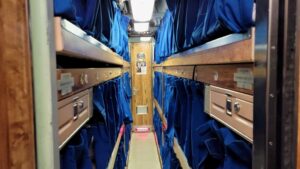
We laughed and were thrilled at the New Jersey Turnpike signs crew members had tacked on the walls, a daily reminder of the name of their boat and its main artery.
We learned about the value of water, since it’s made and stored by the boat. It’s the boat’s needs for water that are met first, then the culinary staff’s needs for cooking and cleaning, assuring cleanliness that prevents so much sickness and disease. Mr. Baldwin was great in describing that showers are more like a “wet, turn off, soap up, shut off, rinse off, shut off” all completed within two minutes or so, since water is at such a premium. Of course there is only one washer and one dryer aboard; shipmates often share a load since here again, the kitchen staff has priority to ensure cleanliness of cooking linens and materials.
What was most fearful was learning that fire is one of the biggest dangers for a sub and its crew, since it takes no more than 12 seconds or so for an area to fill with smoke. A whiff or appearance of any smoke brings the entire crew to immediate attention and action. It explained why there are so many fire hoses and equipment throughout the craft. It’s with pride you learn the United States hasn’t lost a submarine to enemy forces in 60 years or so; it is with a silent prayer you learn we have lost some to fire or flood in less time.
Forward on the boat, we learned about the watertight door and system that separates everything from the reactor, on the lower level we saw the torpedo room, all the while our expert guide trying to put into ordinary terms the sophisticated knowledge we could never absorb.
We learned our New Jersey submarine can go deeper than 800 feet under the sea, and can travel at speeds up to 25 knots, or better. We learned it’s the nuclear reactor making pressurized water that gets the boat moving….Commander Halle had told groups earlier that the New Jersey is a true Jersey girl…she doesn’t pump gas. And we even learned that our wonderful boat, design specifically to keep our nation safe, can surprise inland targets with land-attack missiles and carriers torpedoes, , lots of them, along with Tomahawk missiles, mobile mines and even unmanned underwater vehicles.
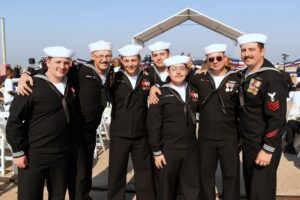
P. Kastrup STS3 of Nebraska; D. Zuckerman Leading Petty Officer from NYC; A. Lewis STS3 from North Carolina; E. Wiser STS3 of Texas; T. Chappell STS2 of California; P. Wardell Leading Petty Officer from Florida, and A. Carlson STS2 from New Mexico Photo Courtesy Gary Lehman
And yes, men and women work in all divisions on a sub, be it electrical, culinary, reactor control, or laboratory control, navigation, torpedoes or Sonar. Seeing them working together it is their camaraderie, their trust and their ability to recognize the need or assistance another needs than you notice; it seems to be a blend on fully integrated men and women who have one purpose in life….to do the best they can at the job they all want to do.
Heading back to the deck of the ship, the ladders were easy, and the narrow walkways effortless and simple. It was only that last hop up from the top of the ladder to the deck and sunshine that took a bit more effort and a firm hand from a shipmate to get to the top.
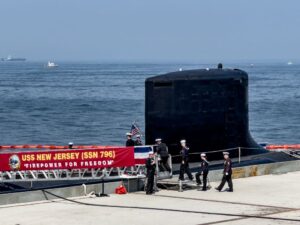


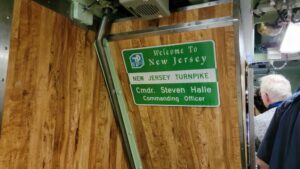
Great article, well written, paced, and very informative. Congratulations on your incredible experience.
This is an excellent article that gives much greater detail than I wrote in my journal of my tour of the sub as well. 🤗 The first step is a doozy; I laughed when I read remembering my husband and daughter laughing at me for the nearly 5 minutes it took for me to muster up the courage to take the first step. Lol! What a magnificent experience and an awesome look into what this crew does and how they live. Thank you!!
Thanks for writing! You got a really great tour! I was also an STS2 best job on the boat.
Glad you got to experience the tight quarters in a sub-amazing how many people fit in the sub and things can get done in so small a space.
Great account. As a commissioning committee member I’m just sorry more people weren’t able to tour the boat. It is a rare experience to see where these young sailors live and work for weeks and potentially months at a time. The submarine is a technical marvel, but the crew with their dedication and training make all the difference!